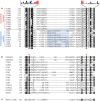Atypical cyclins: the extended family portrait
- PMID: 31420702
- PMCID: PMC6971155
- DOI: 10.1007/s00018-019-03262-7
Atypical cyclins: the extended family portrait
Abstract
Regulation of cell division is orchestrated by cyclins, which bind and activate their catalytic workmates, the cyclin-dependent kinases (CDKs). Cyclins have been traditionally defined by an oscillating (cyclic) pattern of expression and by the presence of a characteristic "cyclin box" that determines binding to the CDKs. Noteworthy, the Human Genome Sequence Project unveiled the existence of several other proteins containing the "cyclin box" domain. These potential "cyclins" have been named new, orphan or atypical, creating a conundrum in cyclins nomenclature. Moreover, although many years have passed after their discovery, the scarcity of information regarding these possible members of the family has hampered the establishment of criteria for systematization. Here, we discuss the criteria that define cyclins and we propose a classification and nomenclature update based on structural features, interactors, and phylogenetic information. The application of these criteria allows to systematically define, for the first time, the subfamily of atypical cyclins and enables the use of a common nomenclature for this extended family.
Keywords: Canonical; Cell cycle; Cyclin family; Phosphorylation; Transcriptional.
Figures



References
-
- Evans T, Rosenthal ET, Youngblom J, Distel D, Hunt T. Cyclin: a protein specified by maternal mRNA in sea urchin eggs that is destroyed at each cleavage division. Cell. 1983;33:389–396. - PubMed
-
- Lim S, Kaldis P. Cdks, cyclins and CKIs: roles beyond cell cycle regulation. Development. 2013;140:3079–3093. - PubMed
Publication types
MeSH terms
Substances
Grants and funding
LinkOut - more resources
Full Text Sources

